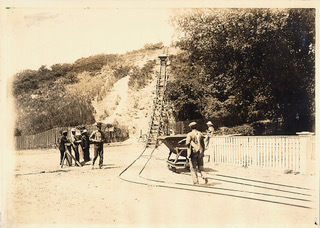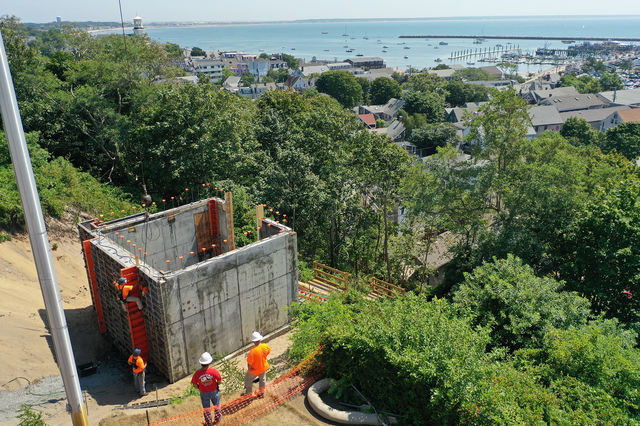

There are about 30 of them in the US; only three are in New England, and soon you’ll be able to use one, too! An inclined elevator, or cable car on rails, will bring visitors from the Bas Relief Park on Bradford Street in the coastal community of Provincetown to the landscaped lawn of the Pilgrim Monument and Provincetown Museum (PMPM).
The Pilgrim Monument provides 360-degree views of the land and harbor, and commemorates the courageous voyage of the Mayflower’s “strangers and saints” in search of personal freedoms and the signing the first governance document in the New World - the Mayflower Compact - in Provincetown Harbor. Located on the outer edges of the mainland, Provincetown has continued to be a haven for pilgrims from all walks of life and is celebrated as the East Coast center of diversity and creativity. With 2020 marking the 400th anniversary of the pilgrims’ landing, the PMPM Trustees decided to move forward with a grand plan to connect the PMPM to the rest of the town as an ongoing legacy of the historic site.

Pouring of the concrete footings
You see, the monument is located on very steep 80 feet tall High Pole Hill, which, while visually impressive, acts as a physical barrier to the site. The isolation from the downtown due to the difficult accessibility have bothered both locals and tourists for years, causing confusion and preventing the kind of back-and- forth foot traffic that would greatly benefit not only PMPM, but also the shops and restaurants of Provincetown. “It seems impossible to hide a 252-foot granite tower, but we have!” says PMPM Board Member Paul DeRuyter.
The need for a connection between Bradford Street and the top of High Pole Hill is a concept that goes back to the original construction of the monument. The path of the new inclined elevator is roughly the same as the path of a trolly rail used in 1908 that carried the granite blocks used to construct the Pilgrim Monument. The granite blocks originated from a quarry in Maine, were barged to Provincetown, then were offloaded and trolleyed up to the top of High Pole Hill.

The site of the new inclined elevator follows the same general path that the original trolly rail used in 1908 to carry the granite blocks used to construct the Pilgrim Monument. The granite blocks were shipped from a quarry in Maine and barged to Provincetown, where they were offloaded and trolleyed up to the top of High Pole Hill.
Civil EngineeringHistoric records indicate that Fredrick Law Olmstead himself had a hand in developing a plan for the public to reach the monument. There is a painting in Provincetown Town Hall depicting a set of grand stairs (think of the Spanish Steps in Rome) ascending to the top of the hill. However, creating a stairway to the Monument grounds was found to be impractical and highly invasive to the hillside, requiring switch back stairs with over 160 steps and multiple landings along the way. The thought of installing a ski-lift type of gondola also proved impractical, but has led to the idea of installing an inclined elevator.
The inclined elevator is a custom-designed single tram system. The tram will run on rails between two 20’x20’ ADA-compliant pavilions at a speeds up to 200 feet per minute. It will be able to transport up to 18 passengers at a time, with a travel time of about two minutes. The hours of operation will vary depending on the season, but it is expected to operate full time during peak season summer months.
The development team that is finally making this project a reality consists of engineers of record Coastal Engineering Company Inc. of Orleans (Coastal), architects Catalyst Architecture/Interiors (formerly Brown, Lindquist, Fenuccio & Raber) of Yarmouth Port, landscape architects Hawk Design Inc. of Sandwich, geotechnical engineers GM2 Associates of Glastonbury, CT, MEP consultant CSI Engineering of Portsmouth, NH, and elevator designer Outdoor Engineering of Switzerland. The construction is handled by Robert B Our Company of Harwich and Jay Cashman Inc. of Quincy.

The development team at work: Engineers of record Coastal Engineering Company Inc. of Orleans, architects Catalyst Architecture/Interiors (formerly Brown, Lindquist, Fenuccio & Raber) of Yarmouth Port, landscape architects Hawk Design Inc. of Sandwich, geotechnical engineers GM2 Associates of Glastonbury, CT, MEP consultant CSI Engineering of Portsmouth, NH, and elevator designer Outdoor Engineering of Switzerland. The construction is handled by Robert B Our Company of Harwich and Jay Cashman Inc. of Quincy.
As engineers-of-record, Coastal Engineering Co. has a long-standing relationship with PMPM, dating back to the award-winning 2012 restoration of the monument’s structural system. Coastal’s structural and historical expertise guided the restoration of the Pilgrim Monument in the direction of a cost-effective, state-of-the-art fiber technology that addressed corrosion-related issues and improved the Monument’s structural integrity. The work also included upgrades to the observation platform and viewing stations. The unique project was performed during the off-season and had aggressive deadlines, all of which were met.
In the inclined elevator project, Coastal Engineering Co. has been involved at multiple levels. The Coastal civil engineering team has developed civil site plans and performed precise field survey layout, the Coastal structural engineering team has designed the foundations and connection points that will support the elevator, as well as the buildings and frames according to the vision of the architect, while the Coastal permitting team has assisted the client through the difficult permitting process.
“The outer Cape surficial geology is essentially a giant sand dune formed from the post glacial deposition of sand and silt from the last advance and retreat of the ice sheet. As such, slope stability and the integrity of the rail support structure were the main considerations of the project.” - John Bologna, P.E., Coastal Engineering Co. President/CEO
The planning process started with an evaluation of the site existing conditions. Cape Cod juts far out into the North Atlantic Ocean and bears the brunt of major storms coming up the Northeast coast. Over the past 100 years, the Pilgrim Monument has stood tall, withstanding the forces from Great New England Hurricane of 1938, Hurricanes Edna and Carol in 1954, and Hurricane Bob in 1991. “The site locus is subject to 138 mph, 3-second gusts of wind and is a designated hurricane prone area,” says Bologna. “The elevator foundation structure had to be designed for high winds and snow using gravity, wind, and seismic specifications from Minimum Design Loads and Associated Criteria for Buildings and Other Structures (ASCE/SEI 7-16).”
Helical piles installed up to 45 ft deep will not only support the foundations but also improve the global stability of the site. There are over 50 helical piles associated with the project. Some will be installed at an angle, serving as tiebacks for the tension load produced by the mechanism itself. Others act as conventional compression piles, and still others (at the bottom of the hill) act to resist buoyancy in the event of area flooding.

Contractor removes forms for the Upper Platform walls
The lower pavilion is located in a mapped flood zone (AE EL=10) and has the landing at the Base Flood Elevation; however, the elevator pit is located below grade to house some of the elevator mechanisms. As such, the elevator pit had to be designed for both the high ground water levels and for hydrostatic flood forces on the structure. To install the elevator pit, a sheet pile cofferdam enclosure was built, dewatered, and then fitted with a precast concrete box that was also anchored with helical piles to form the lower section of the elevator pit, Bologna says.
The mechanism and hoist for the elevator will be located at the top of the hill. The piers and upper pavilion and rail foundations have been designed to enable the hoist mechanism to pull the elevator up the hill without affecting the stability of the nearby Pilgrim Monument.
The coordination of structural components with the mechanical components were particularly challenging. Specifically, accommodating the precisions demanded by the machinery while understanding civil and structural construction tolerances and anticipated structural deflections.
Another important aspect of the project was developing a design that was respectful of the historical status as a national historic monument.

Contractor removes forms for the Upper Platform walls
After years of planning, design, and construction, the elevator is finally operational and transports visitors up High Pole Hill, treating them to spectacular views along the way. Not only it fulfills the PMPM plan to commemorate the 400th anniversary of the pilgrims’ landing, but also provides easy, fun, and ADA-accessible connectivity between Provincetown’s harbor-side downtown and the historic Pilgrim Monument and Provincetown Museum site, all in grand style. Whether visitors to Provincetown are looking to connect with those first settlers, explore the rich history of the town, or simply take in the spectacular views from the top of the hill and monument, they have an easy time doing it, all while being only steps away from the restaurants, galleries and other attractions that make the town such a sought-after destination.
Please contact us to learn more about professional civil and structural engineering services!